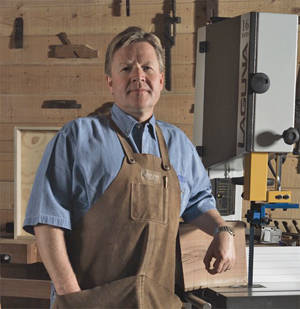
here are, of course, many differences between European and North American woodworkers, and Torben Helshoj, president of Laguna Tools, has had ample opportunity to observe those differences. Torben grew up in Denmark and did his woodworking apprenticeship with a very exclusive shop over there. It was so high-end, they made furniture for the Queen of Denmark as well as Saudi Arabian sheiks and various other dignitaries. He would be the first to admit that it was a learning experience that would inspire envy in most woodworkers.
He’s been in the U.S. now for more than 15 years, founding and running Laguna Tools, a woodworking machinery company that makes some of the highest quality power tools* from Europe available to American woodworkers. Having been raised in a European apprenticeship, Torben has some interesting observations on the North American way of learning woodworking and the more formal apprenticeship process that is used in Denmark.
“When you have to fight for something, you sometimes learn more and learn faster and learn better. And that’s the system we’ve got going here in the U.S. If you want to learn something, you must really go get it. Whereas in the European system, the learning is served on a plate to you,” says Torben. While the latter system turns out a lot of competent woodworkers, he says, the U.S. method of more self-directed learning creates some really fine woodworkers who have enthusiastically sought to improve their skills.
Torben, however, doesn’t pull any punches. “For the majority of woodworkers, certainly the European system is far, far superior because it has a formal apprenticeship program and schools. But for the few elite woodworkers, I think this country has just as much to offer,” he says.
Half a Saw
Another difference between the two woodworking cultures, says Torben, is the kinds of tools each prefers. Here in North America, for example, the typical 10″ table saw is fine in terms of quality, but it seems a bit stripped down to European eyes. “You would have a very, very hard time giving one of those machines away in Europe,” says Torben, because it doesn’t have a sliding table or any of the other fences and gadgets that are standard to table saws over there.
Straight out of the box, he says, these table saws are really only designed to rip. Not to put too fine a point on it, the typical North American table saw seems like half a saw says Torben. Europeans, he says, can’t believe we spend so much time building jigs and extensions that the manufacturers should have put there in the first place.
Of course, this plays into the strengths of the tools his company imports. Laguna provides a lot of combination tools–tools that can plane and joint or table saws that are also shapers. The conventional wisdom is that Europeans like multipurpose tools because they don’t have much room in their shops for a lot of separate bench tools, but Torben isn’t sure he buys that argument. Most European woodworkers have their shops either in their basement or their garage; he estimates that about 90 percent of North American woodworkers are in the same position. Only a few have separate shops built entirely for the purpose of woodworking, says Torben. And European garages and basements are that much smaller.
He says that North American woodworkers are coming around to the idea of more multipurpose power tools, as indicated by the increased sales of the tools his company provides.
A Woodworking Workforce?
In the upcoming issue of Woodworker’s Journal (Oct. 2000), we will be reporting on Laguna’s work helping inner city youth learn woodworking skills that will make them employable. While Torben originallygot involved in this project out of sense of giving back to the the community, he’s also concerned about having enough well-trained woodworkers that can work in professional shops. He’s contacted many shops in his area and all are very enthusiastic.
As in a lot of industries, skilled workers are becoming a scarce resource. And skilled woodworkers who can go into a professional shop can, he says, almost name their price. “I don’t know one woodshop that isn’t looking,” says Torben.
That’s why he’s currently contemplating a homegrown apprenticeship system for the disadvantaged kids currently in his shop. It would start with a 10-week program where the young people could just chew up some wood and:
– learn to saw a straight line
– sharpen a chisel
– sand
– cut a dovetail
– and do some general hand work
He wouldn’t expose them to power tools until later. Then he would ship each apprentice out to a professional shop for three months before bringing each back for more instruction. His program might then run them back and forth to a series of shops until each became a skilled woodworker with a diverse set of skills. This program is still early in the planning stages, but Torben suggests, “we are thinking that in three or four years, we can create a well-rounded woodworker.”
-Bob Filipczak





